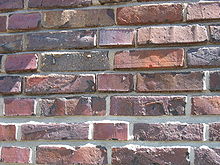St. Anton (Augsburg)
The Roman Catholic parish church of St. Anton in the Antonsviertel in Augsburg was consecrated on May 26, 1927 by Auxiliary Bishop Karl Reth. The church, a bare brick building with a two-tower facade, is located right next to Wittelsbacher Park and stands out for its modern architecture and the unusual building material clinker . St. Anton is one of the most important sacred buildings of the first half of the 20th century in Germany. The architect Michael Kurz even achieved international recognition for the building. The building, which was undamaged during World War II, is now a monument .
History of origin
The church building association was founded on February 16, 1897. It was not until 25 years later, on May 26, 1922, after the necessary money had been collected and new ideas and plans had been discussed again and again, that the Augsburg church administration announced an architectural competition.
Michael Kurz took fourth place with a very modern, expressionist proposal. Since none of the ten submitted competition entries seemed suitable for an unchanged takeover, he was finally commissioned to further develop his plans. In March 1924, he presented his new Christocentric design, which was then implemented. Michael Kurz was already a recognized church builder , he had built the Herz-Jesu-Kirche in Augsburg from 1907 to 1909 .
The groundbreaking ceremony for the laying of the foundation stone took place on November 9, 1924. A year later, the shell was finished and the topping-out ceremony was on November 14, 1925.
Equipment and special features
The large crucifix was created by Karl Baur in 1929. In the following year, the two side altars were erected and the glass paintings were inserted. The Theresa Altar was built in 1933 and the pulpit by Karl Baur in 1934. Also by Baur are the choir organ (1935) and the Antonius altar with statue of Anthony (1935) as well as the evangelist figures (1935). In 1936 the Munich painter Albert Burkart painted the Antonius Chapel.
Organs
Main organ
The St. Anton organ is the largest instrument in Augsburg with a remarkable 83 stops . It was built by Josef Zeilhuber in 1931 , expanded in 1971 and thoroughly renovated in 2018. In addition, a new console by master organ builder Siegfried Schmid could be installed in 2020 . The choir organ in the choir can also be played from here via fiber optic cable. The disposition of the main organ is:
|
|
|
|
|
||||||||||||||||||||||||||||||||||||||||||||||||||||||||||||||||||||||||||||||||||||||||||||||||||||||||||||||||||||||||||||||||||||||||||||||||||||||||||||||||
-
Coupling : Normal coupling: IV / III, IV / II, IV / I, III / II, III / I, II / I, IV / P, III / P, II / P, I / P,
- Super octave coupling: III / III 4 ', III / II 4', III / I 4 ', II / II 4', II / I 4 ', II / P 4'
- + Sub-octave coupling: III / III 16 ', III / II 16', III / I 16 ', II / II 16', II / I 16 ', I / I 16'
-
Playing aids :
- 10,000-fold typesetting system with sequence switch
- Equallage from
- roller
- Transpose device: -6 / + 6 semitones
- Remarks
- ↑ The electronic glockenspiel is not tied to a manual.
Choir organ
In addition, St. Anton has a choir organ. It has its own console, but can also be played from the main organ via fiber optic cable. Your disposition is:
|
|
|
|||||||||||||||||||||||||||||||||||||||||
- Coupling : CHO II / I, CHO II / II, CHO II / III, CHO II / IV; CHO II / P, CHO I / I, CHO I / II, CHO I / III, CHO I / IV, I / P
One of the special features of the church is its external appearance. It received an outer wall made of hard-fired clinker from near Oldenburg in northern Germany. Clinker bricks are considered to be very weather-resistant and versatile. The model for the facade of St. Anton was provided by the Chilehaus in Hamburg's Kontorhausviertel , which was also made of Bockhorn clinker. Critics criticized the use of the material, which in Bavaria was regarded as “not down to earth”. However, it brought the church great attention even beyond Bavaria.
Web links
- St. Anton Augsburg , official website
- St. Anton on augsburger-kirchen.de
Individual evidence
Coordinates: 48 ° 21 '27 " N , 10 ° 53' 4" E


